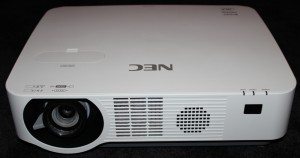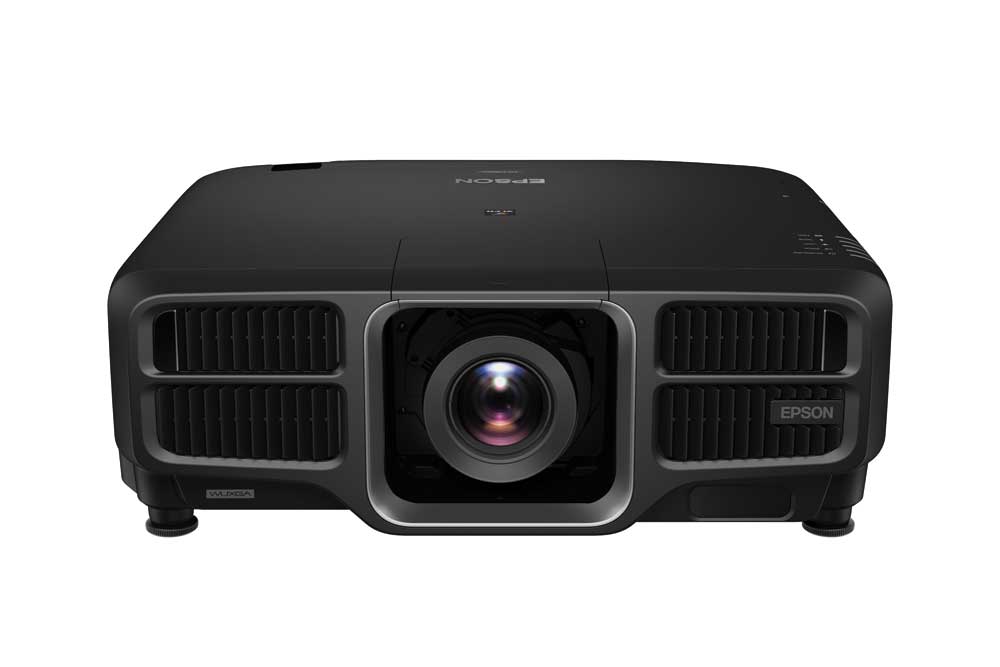Let's start with the difference in “lamp life,” by stating that lamp based projectors continue to increase their claimed life. When the modern lamp projectors first the market back around 1995, the typical lamp life was 500 hours.
It should be noted that with lamps, hybrids and laser projectors, the manufacturer’s claim in hours is not how long you should expect the lamp/hybrid/or laser to last, but how long until brightness of the light engine drops to 50% of original brightness. (I’ll bet some of you weren’t aware of that since manufacturers essentially never explain that in their brochures.)
Today, at full power, most lamp based projectors claim between 3000 and 6000 hours, with some exceptions as low as 2000 hours (generally the large venue - brightest projectors claim the shortest lamp life) – again, we’re talking full power. 5000 to 8000 hours is becoming more common for lamp projectors running in their less bright eco modes.

The NEC-P502WHL offers 5000 lumens and a laser light engine for a surprisingly low MSRP of $4699. Until recent announcements, this was about as close to affordable as WUXGA laser projectors were.
By comparison, laser projectors running at full power seem to start at 16,000 – 20,000 hours, and each year those numbers have been improving. There are laser models out there running less than full power, now claiming 30,000 hours – which is merely four years running 24/7, but more practically, a 20,000-hour laser projector works out to roughly 40 hours a week for a decade. Now that, folks, is low maintenance!
Costs Relating to Lamp Based Projectors
The first thing everyone thinks about when it comes to replacing lamps in projectors – everyone, except the IT/AV people responsible for multiple projectors, is the cost.
The good news is lamps are mostly getting less and less expensive. Some major manufacturers are down to $150 list price, or even less for a replacement lamp, but yes, there are still those charging $400 or even more. In the education market, some models even have replacement lamp costs as low as $79.
Now that sure seems reasonable enough!
Unfortunately, at least for low-cost lamps, the lamp price itself is the least of the associated costs. First, the lamps must be obtained – figure out what model, find a source, and order/pay for the replacement lamp. (Note: A company or educational institution with a lot of projectors might buy lamps in quantity, saving some time.) For those with a single projector, getting a replacement lamp might be as easy as searching Amazon or Best Buy, or contacting the AV dealer the projector was first purchased from. For a larger company, it might be purchase orders, shipping departments involved.
Great! But, ultimately now you have a lamp to replace the failed one (or one that just got too dim), or the color shifted too much (that last mostly when using multiple projectors together in edge blending or projection mapping setups).
Who’s going to replace the lamp? Well, first of all, most projectors today are mounted, usually to the ceiling, or the wall above a screen. We’re talking ladders, and someone who basically knows what to do. Most projectors today that are mounted, allow the lamp to be replaced without having to un-mount the projector (thankfully, because if you have to un-mount, the extra time involved gets somewhat prohibitive.
OK< you have one projector wth a lamp out. Get out the ladder, undo a screw or two (make sure the projector has been off, and cool). Remove the lamp. Put in the replacement. Now figure out how to dispose of the old lamp – they all contain mercury, so their not supposed to go in the trash (just like those CFLs).
Now imagine you are responsible for 400 projectors in a school district. Let’s say you expect an average of 4 years per lamp. That’s 100 lamps a year – spread out over, what, 20-30 schools in a district. Starting to get the idea of how much time is involved in labor, and perhaps transportation. Maintaining a lamp based projector fleet can require a lot of resources. If you figure 1-3 hours per projector, 100 projectors a year is 2.5 to 7.5 man –weeks (at $1000 per man-week). I’ll let you finish the math. The point is, there is a real cost if you have a lot of lamp based projectors you need to keep operational over several years!
By comparison, other than a premature failure, few laser projectors will need any maintenance over their usual lifetime, which should be at least a decade. Figure to get to that same 10 years, you are probably looking at at least 1 lamp replacement, but probably 2-4, depending on how long the lamps last.
Huge savings in cost of replacement lamps, but more importantly in time and labor.
Lamp Life Consistency
If you have a lamp rated 4000 hours, a significant portion of them may fail by 2000 hours (figure 10% or more). Others will last 5,000, 6000, or even more hours. My point is, they are pretty unpredictable, so don’t expect to get 90% of those 4000 hour lamps, failing, say between 3600 and 4400 hours.
Laser vs. Lamp in Constant Brightness, or Accurate Color Applications
Today these situations are mostly larger venue, and in such cases like edge blending 8 projectors at a museum, the laser’s consistency advantage is huge, but because we’re focusing on the more affordable laser projectors, we won’t discuss these more complex applications in this article.

Large Venue Projector from Epson - the L1505 with 12,000 wall melting lumens, and it's loaded. But it’s only an “affordable laser” if you can surgically drop one 9 from it’s $21,999 price! Just what you need to present to a couple thousand souls, a multi-story museum display, or a mega-church! It does mulit-projector edge blending, projection mapping and a host of other things not needed in a basic installation laser projector.
Are Laser Projectors Inherently Far More Reliable?
I would answer this question with a resounding YES, but only as far as comparing the reliability of the laser engine, vs the lamp engine. All projectors have power supplies, circuit boards, fans (well, most), and other components, which tend to be the same for both laser and lamp-based projectors. That means that while the laser engine may have the huge life and maintenance advantage, in other areas, of potential failure, they are similar. Just remember, with lamp projectors you can count on having to do some maintenance for the lamps. Both laser and lamp projectors may also have filters to replace, but I will point out that laser projectors are far more likely to have long life filters requiring replacement only 5000 to 20,000 hours.
Disadvantages of Laser Projectors vs. Lamp Projectors
The obvious disadvantage of laser projectors today is the higher upfront costs. If you have a fixed budget, you might be able to purchase only 5 laser projectors of a given brightness and feature set, compared to 7 or 8, or in some cases 10 lamp based projectors.
That, of course, is a critical decision in some companies and schools. I suspect, however, that is an issue that mostly affects K-12 schools, but far less so, for business, higher education, entertainment venues, and houses of worship. Other than K-12, organizations can look at the projected short and long term costs, and may decide that spending more now, makes sense in the long run.
So how much more will it cost for that laser projector? From a list price standpoint until recently, you could say that at least $2000 more for a laser. But that statement goes right out the window when we consider that Sony just announced a laser projector for $2199. And that lamp based projectors that are otherwise similar are definitely over $1000.
After that, It depends on the overall brightness and feature sets.



